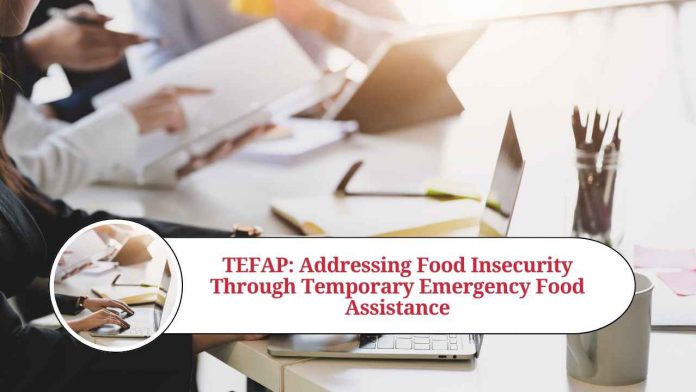Introduction
In a world where access to nutritious food should be a basic right for everyone, the reality is that many individuals and families face food insecurity on a daily basis. To combat this pressing issue, governments and organizations have implemented various programs aimed at providing temporary relief to those in need. One such program is the Temporary Emergency Food Assistance Program (TEFAP), which plays a crucial role in addressing hunger and ensuring that vulnerable populations have access to essential food resources. In this blog post, we will explore TEFAP, its objectives, implementation, and the impact it has on communities across the United States.
Understanding TEFAP
TEFAP is a federal assistance program administered by the United States Department of Agriculture (USDA) that provides food to low-income individuals and families through partnerships with states, local agencies, and food banks. Established in 1981, TEFAP operates in all 50 states, the District of Columbia, and several tribal nations, making it one of the largest food assistance programs in the country.
Objectives of TEFAP
The primary objective of TEFAP is to reduce hunger and improve nutrition by distributing nutritious food to eligible individuals and households. The program focuses on providing emergency food assistance to low-income individuals, particularly those at risk of hunger due to unemployment, underemployment, or other economic challenges. By ensuring a stable food supply, TEFAP aims to alleviate immediate hunger and improve the overall health and well-being of vulnerable populations.
TEFAP Implementation
TEFAP operates through a network of local agencies, including food banks, food pantries, soup kitchens, and shelters. These agencies play a vital role in the distribution of food to individuals and families in need. The USDA provides food to state agencies based on a formula that takes into account each state’s caseload of low-income individuals and the number of unemployed persons. The state agencies, in turn, distribute the food to eligible local agencies within their jurisdiction.
TEFAP food packages include a variety of nutritious food items such as fresh produce, dairy products, meat, poultry, fish, grains, and other staples. The types and quantity of food provided may vary based on availability and the specific needs of the community. TEFAP also supports nutrition education initiatives to promote healthy eating habits among program participants.
Eligibility and Access to TEFAP
TEFAP eligibility is based on income and household size. Individuals or families must have incomes at or below 185% of the federal poverty guidelines to qualify for assistance. Eligible participants include low-income individuals, seniors, unemployed individuals, and households experiencing financial hardship.
To access TEFAP, individuals can contact their local state agency or community-based organizations involved in food distribution. These agencies help determine eligibility and connect individuals with available resources. TEFAP operates in conjunction with other federal assistance programs like the Supplemental Nutrition Assistance Program (SNAP) to provide a comprehensive safety net for vulnerable populations.
Impact of TEFAP
TEFAP plays a crucial role in alleviating food insecurity and providing temporary relief to individuals and families in crisis. By working in collaboration with local agencies and community-based organizations, TEFAP ensures that food reaches those who need it most. The program not only addresses immediate hunger but also contributes to long-term food security by promoting healthy eating habits and nutrition education.
TEFAP’s impact extends beyond the individuals and families it serves. By reducing food insecurity, the program strengthens communities and supports the overall well-being of society. It helps to bridge the gap between food waste and food insecurity by redistributing surplus food to those in need, reducing food waste and environmental impact.
Conclusion
In the face of ongoing food insecurity challenges, programs like TEFAP play a vital role in providing temporary emergency food assistance to vulnerable populations. By addressing immediate hunger and promoting nutrition education, TEFAP not only helps individuals and families in need but also strengthens communities as a whole. As we continue to work towards a more equitable and hunger-free society, it is essential to support and advocate for programs like TEFAP that aim to ensure everyone has access to the nutritious food they need to thrive.
Read More Useful Content:
- Top Benefits of E-Invoicing Software For Your Business
- Best e-Invoicing Software to Simplify Your GST e-Invoicing
- E-invoicing – Guide On E-Invoicing System In India
Frequently Asked Questions (FAQs)
What is TEFAP?
TEFAP stands for Temporary Emergency Food Assistance Program. It is a federal assistance program in the United States that provides food to low-income individuals and families through partnerships with states, local agencies, and food banks.
Who is eligible for TEFAP?
Eligibility for TEFAP is based on income and household size. Individuals or families must have incomes at or below 185% of the federal poverty guidelines to qualify for assistance.
How does TEFAP distribute food?
TEFAP operates through a network of local agencies such as food banks, food pantries, soup kitchens, and shelters. The United States Department of Agriculture (USDA) provides food to state agencies, which then distribute it to eligible local agencies within their jurisdiction.
What types of food does TEFAP provide?
TEFAP food packages include a variety of nutritious food items such as fresh produce, dairy products, meat, poultry, fish, grains, and other staples. The specific types and quantity of food provided may vary based on availability and community needs.
How can I access TEFAP?
To access TEFAP, individuals can contact their local state agency or community-based organizations involved in food distribution. These agencies help determine eligibility and connect individuals with available resources.
Does TEFAP work with other assistance programs?
Yes, TEFAP works in conjunction with other federal assistance programs like the Supplemental Nutrition Assistance Program (SNAP) to provide a comprehensive safety net for vulnerable populations.
Is TEFAP only available in certain states?
No, TEFAP operates in all 50 states, the District of Columbia, and several tribal nations. It is a nationwide program aimed at addressing food insecurity across the country.
Can seniors and unemployed individuals benefit from TEFAP?
Yes, TEFAP is available to seniors, unemployed individuals, and households experiencing financial hardship. It is designed to provide temporary relief to those in need.
How does TEFAP contribute to long-term food security?
TEFAP not only addresses immediate hunger but also supports long-term food security by promoting nutrition education initiatives and encouraging healthy eating habits among program participants.
How does TEFAP impact communities?
TEFAP plays a crucial role in alleviating food insecurity and strengthening communities. By providing access to nutritious food, the program helps bridge the gap between food waste and food insecurity, reducing waste and supporting the well-being of society as a whole.




















